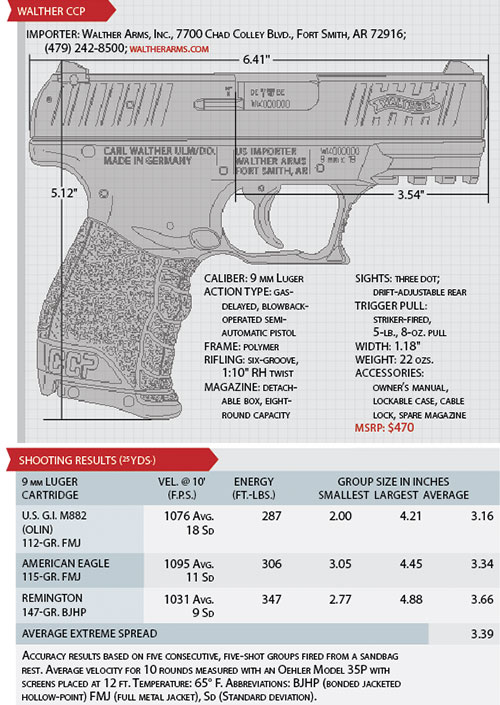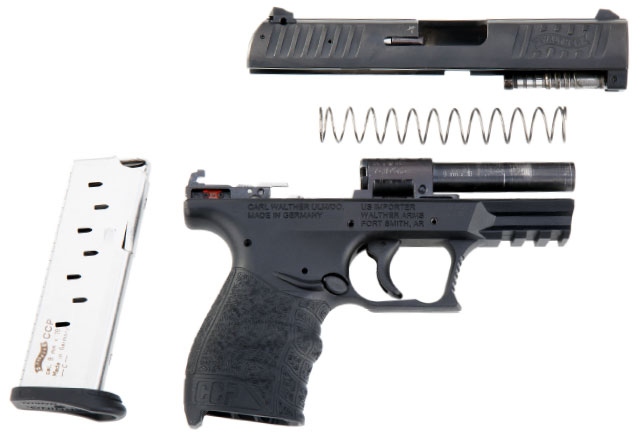There is no one left at the
Walther plant who remembers the last time the legendary gunmaker tried to build a gun like this. It was in the 1930s, and the gun was the MP—a pistol that never went into serial production. An earlier gun, the Walther Model 6 (1914-1917), suffered the same fate. Both pistols were chambered for the 9 mm Luger cartridge, and both were of the blowback operating system. The major reason why such a gun would be desirable is because a blowback system can be made more compact and less expensively than 9 mm recoil-operated models. Blowback means that the breech of the pistol is not locked at the instant of firing, but is slowed in its rearward movement by the weight of the recoiling parts or the strength of the recoil spring—or both. You can build such a gun for the 9 mm Luger cartridge, but the recoil spring has to be so strong that many people cannot easily retract the slide, or the slide is so heavy that the gun is impractical to carry—or both. Since those early days, other makers have tried the same trick. While the goal of a medium-size 9 mm Luger pistol of simple blowback design is certainly worthwhile, it never seems to happen.

The CCP’s grip area features a molded groove for the shooter’s middle finger and rounded ridges for the rest. The slide also includes cocking serrations on both its fore and aft sections.
Still, we are confronted with a new Walther 9 mm pistol that is compact enough to conceal, light enough to carry and powerful enough for serious defensive work. Implementing a form of gas-delayed blowback, the new Walther CCP 9 mm fills the increasingly attractive niche of a medium-size, single-column, simple-trigger carry pistol. Guns with these characteristics are available from several recognizable competitors. In past years, several makers have offered gas-delayed blowback 9 mm and even .40 S&W guns, so the basic idea is not new. However, Walther’s approach to getting recoil-operated performance from a blowback pistol is a refinement of the concept.
In typical recoil-operated 9 mm pistols, the barrel is temporarily locked to the slide as the recoil stroke begins. After brief travel, a cam arrangement causes the barrel to unlock from the slide, which continues rearward for extraction, ejection, feeding, etc. In a blowback, the barrel is fixed and the recoil spring holds the breech closed. The 9 mm Luger cartridge develops pressures high enough that it will destroy a simple blowback in short order. A workable solution is to use some of the propellant gases to delay the slide’s violent rearward movement until pressures drop to a safe level. Although there are superficial resemblances between gas-operated firearms and gas-delayed ones, they are very different. The former advance movement; the latter retard it.

The CCP’s piston resides in a gas cylinder in the frame directly under the fixed barrel (arrow) when the gun is assembled.
The CCP has a barrel fixed to the receiver and surrounded by the recoil spring. Below the barrel is a gas cylinder mounted in the polymer receiver. The conventional-looking slide has a downward extension at the lower front end to which a piston is pinned. The piston can move up and down a bit, and, when the pistol is assembled, its head resides in the gas cylinder. Just forward of the barrel’s firing chamber, a port directs the flow of gases downward into the cylinder. The pistol fires and the slide attempts to move rearward; however, it cannot because gas from the fired cartridge is not only pushing the bullet toward the muzzle, it is also running down through the port and into the cylinder. The gas presses against the tip of the piston, preventing the slide, to which it is attached, from slamming backward.

When the bullet leaves the muzzle of the gun, pressure drops instantly and the system depressurizes. At this point, there is no remaining gas to hold the slide forward, so it recoils for extraction and ejection of the fired cartridge. But there is one additional benefit to the way Walther engineers laid out this unique pistol. As the slide comes back, it brings the piston with it. When the tip of the piston passes the gas port, it enters the rearmost extension of the gas cylinder. There is an easy slip fit, but the fast-moving piston has to compress the air that’s trapped in the closed back end of the cylinder. It is a little like a simple tire pump. It is, in fact, a simple pneumatic buffer. The practical effect is to soften the blow when the slide, with connected piston, is all the way to the rear. The system also permits the designers to use a somewhat less robust recoil spring. This has an impact on gun handling in that the softer recoil spring is much easier for smaller, weaker hands to compress when chambering the first round. It’s win-win-win, when you give the gun the gas.

The result of all that engineering is a concealed carry semi-automatic that fits into an interesting size niche. Not a mini-gun like the Rohrbaughs and smaller Kahrs, and certainly not a full-size pistol like the service Beretta, S&W, Ruger, et al., the CCP is a single-column 9 mm personal defense gun. It weighs just 22 ozs. empty, and measures 6.41"x5.12"x1.18" with a 3.54" barrel. The magazine holds eight rounds for an on-board total of nine. For those who need them, magazines with a two-round extension are available. Internally there is a typical disconnector system, along with a drop safety. Also, Walther engineers put a simple manual safety (up for safe, down to fire) on the left side of the frame. Since the striker is fully cocked, the trigger has only to release it to fire. After doing so, trigger reset is well forward. This may have been done deliberately for safer handling. During testing, I found that even though the trigger pull was not particularly heavy, and that it could be managed, it was full of bumps and starts coming back and going forward for reset. If all CCP pistols exhibit that trait, Walther is going to take some heat over it. The gun’s sights are made of polymer with three-dot highlights. They proved easy to acquire and did not snag on holsters or clothing.

Removal of the CCP’s slide from its frame requires the use of a disassembly tool, included with the gun, or a similarly shaped tool such as a screwdriver.
Overall, the CCP’s ergonomics are very appealing. Every shooter who examined the sample gun had good things to say about the light weight and shootable grip. The gun is similar in size to the classic Walther PP or some of the pocket pistols of the early 20th century. It is a size that could be concealed, but performs like a full-size service pistol. Handling and ergomonics are improved thanks to the CCP’s grip design, which has a finger groove for the middle and rounded ridges for the rest. It fits and works well, with no notable recoil-control problems. Even the slide is contoured for pleasing appearance and handling efficiency. Its sides are curved and have panels of cocking serrations fore and aft. It does not have the square, blocky shape of pistols from most contemporary European factories. The gun also includes an accessory rail on the dust cover.

The CCP’s piston works in conjunction with a gas port in the barrel to retard the rearward movement of the slide until the bullet leaves the muzzle and the system depressurizes.
At the range, I first fired the CCP rapidly, checking for a feature that plagued other gas-delayed pistols—heat. I don’t know what the Walther designers did to prevent it, but the gas cylinder of this gun doesn’t heat up enough to be noticeable. I also checked for function with limp-wristed shooting and with the gun turned upside down, right, left, etc. There were no malfunctions of any kind. With the selected loads, accuracy was adequate for close-range shooting.
By designing the CCP around the gas-delayed blowback action, Walther is able to offer a carry-size 9 mm Luger that is surprisingly soft-shooting. And despite its somewhat problematic trigger feel, it features excellent ergonomics. The CCP is unquestionably innovative, and its unique characteristics make it particularly well-suited to today’s concealed-carry marketplace.



 When the bullet leaves the muzzle of the gun, pressure drops instantly and the system depressurizes. At this point, there is no remaining gas to hold the slide forward, so it recoils for extraction and ejection of the fired cartridge. But there is one additional benefit to the way Walther engineers laid out this unique pistol. As the slide comes back, it brings the piston with it. When the tip of the piston passes the gas port, it enters the rearmost extension of the gas cylinder. There is an easy slip fit, but the fast-moving piston has to compress the air that’s trapped in the closed back end of the cylinder. It is a little like a simple tire pump. It is, in fact, a simple pneumatic buffer. The practical effect is to soften the blow when the slide, with connected piston, is all the way to the rear. The system also permits the designers to use a somewhat less robust recoil spring. This has an impact on gun handling in that the softer recoil spring is much easier for smaller, weaker hands to compress when chambering the first round. It’s win-win-win, when you give the gun the gas.
When the bullet leaves the muzzle of the gun, pressure drops instantly and the system depressurizes. At this point, there is no remaining gas to hold the slide forward, so it recoils for extraction and ejection of the fired cartridge. But there is one additional benefit to the way Walther engineers laid out this unique pistol. As the slide comes back, it brings the piston with it. When the tip of the piston passes the gas port, it enters the rearmost extension of the gas cylinder. There is an easy slip fit, but the fast-moving piston has to compress the air that’s trapped in the closed back end of the cylinder. It is a little like a simple tire pump. It is, in fact, a simple pneumatic buffer. The practical effect is to soften the blow when the slide, with connected piston, is all the way to the rear. The system also permits the designers to use a somewhat less robust recoil spring. This has an impact on gun handling in that the softer recoil spring is much easier for smaller, weaker hands to compress when chambering the first round. It’s win-win-win, when you give the gun the gas.








































